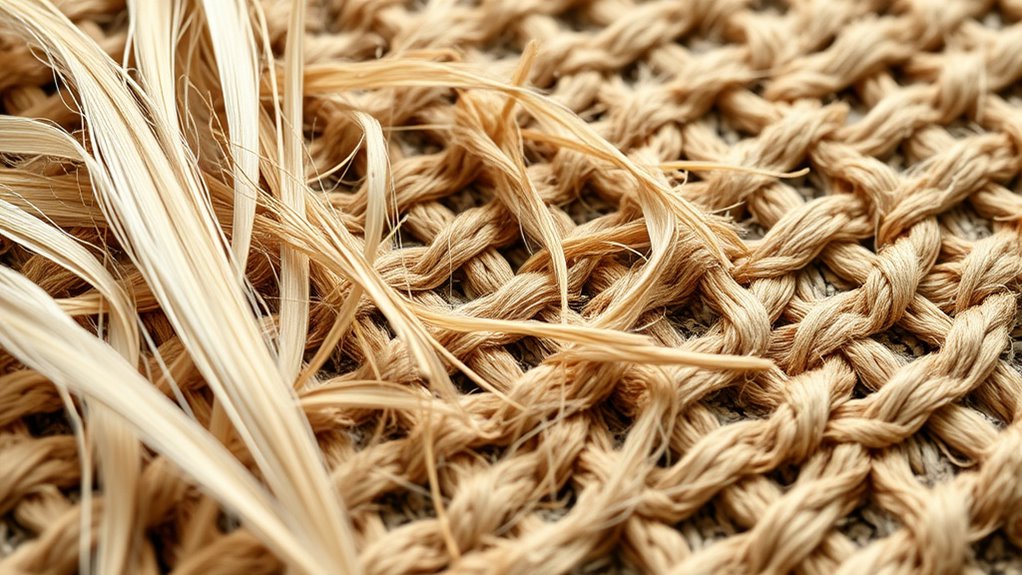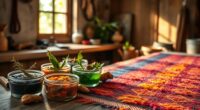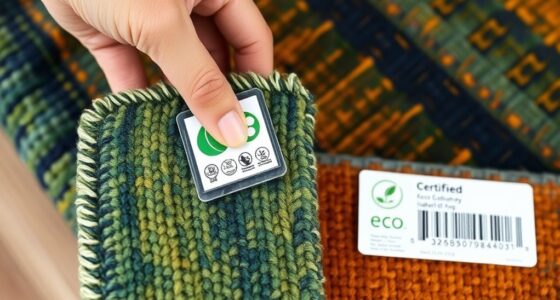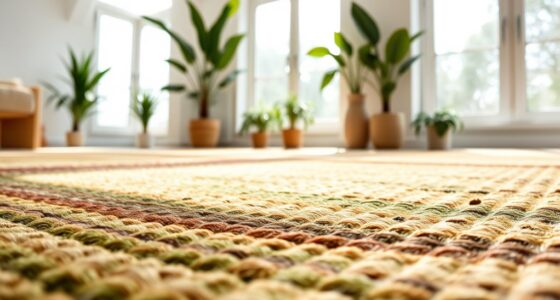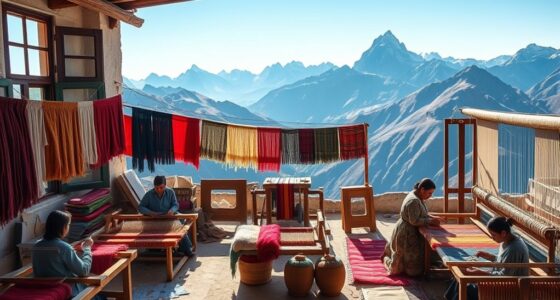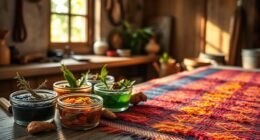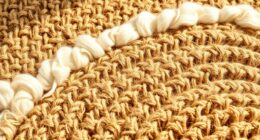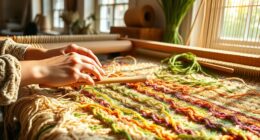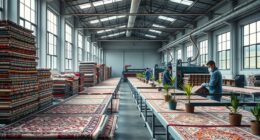Renewable fibers like Tencel, sisal, and sea-grass offer eco-friendly options for luxury rugs that are both sustainable and stylish. Tencel is made from sustainably farmed eucalyptus trees, while sisal and sea-grass grow quickly with minimal water and pesticides, supporting responsible harvesting. These fibers are paired with eco-friendly dyes that reduce chemical use and water waste. By choosing rugs crafted from these materials, you support environmental health and responsible resource management—discover more about their benefits below.
Key Takeaways
- Tencel, sisal, and sea-grass are renewable fibers sourced from sustainably farmed or naturally regenerating plants.
- These fibers require minimal water, pesticides, and chemicals, reducing environmental impact.
- Eco-friendly dyes and production methods further enhance their sustainability and safety.
- Using renewable fibers supports responsible resource management and ecosystem health.
- Rugs made from these fibers offer eco-conscious luxury with durability and natural beauty.
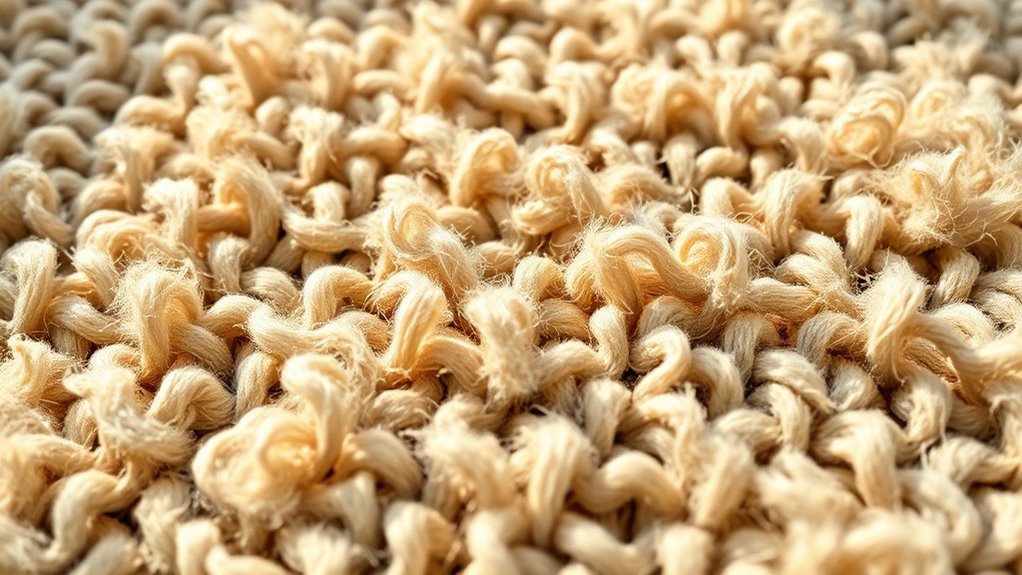
Luxury rugs are increasingly embracing renewable fibers to combine elegance with sustainability. As a conscious consumer, you’re likely seeking pieces that not only elevate your space but also align with eco-friendly values. When it comes to sustainable sourcing, fibers like Tencel, sisal, and sea-grass stand out for their minimal environmental impact. Tencel, made from sustainably farmed eucalyptus trees, is produced using eco-friendly dyes that reduce chemical use and water consumption. This means you can enjoy a luxurious rug without compromising your commitment to the planet. The process of sourcing these fibers emphasizes renewable resources, ensuring that the raw materials are replenished faster than they’re used, reducing the strain on natural ecosystems.
Choosing a rug with renewable fibers also means supporting responsible harvesting practices. For example, sisal is derived from the agave plant, which grows quickly and requires little water or pesticides. Its cultivation doesn’t threaten biodiversity or deplete soil health, making it a sustainable choice. Sea-grass, harvested from coastal regions, regenerates naturally without the need for intensive farming. Its quick growth cycle ensures that it remains a renewable resource, and its collection doesn’t disturb marine habitats when done responsibly. By opting for these fibers, you’re making a statement about your values—prioritizing durability, beauty, and environmental stewardship.
Sisal and sea-grass are sustainable fibers that grow quickly, require minimal resources, and support eco-friendly harvesting practices.
The use of eco-friendly dyes in these rugs further enhances their sustainability profile. Traditional dyeing methods can involve toxic chemicals that pollute waterways and harm ecosystems. However, manufacturers now utilize natural or low-impact dyes that are safer for the environment and for the artisans who apply them. These dyes often come from plant-based sources, reducing the reliance on synthetic chemicals and lowering water and energy consumption during production. When you select a rug dyed with eco-friendly dyes, you’re supporting a cleaner, greener supply chain. This not only benefits the environment but also ensures that your rug remains free of harmful substances, making it safer for your family.
Incorporating renewable fibers with eco-friendly dyes into your home isn’t just a trend; it’s a meaningful way to make your living space more sustainable. It shows your commitment to reducing your carbon footprint while still enjoying the sophisticated aesthetic that luxury rugs provide. These fibers and dyes work together to create pieces that are not only visually stunning but also environmentally responsible. So, whether you’re adding a statement piece to your living room or a subtle accent to your bedroom, choosing a rug made from renewable fibers with eco-friendly dyes allows you to indulge in elegance while staying true to your eco-conscious principles. Recognizing the importance of sustainable sourcing can help you make even more informed, environmentally friendly choices in your home decor.
Frequently Asked Questions
How Sustainable Are the Harvesting Methods for These Fibers?
You’ll find that the harvesting practices for these fibers are generally sustainable, with careful attention to environmental impact. Tencel comes from sustainably managed eucalyptus plantations, while sisal and sea-grass are harvested manually without heavy machinery. These practices minimize habitat disruption and reduce waste. Overall, their harvesting methods prioritize eco-friendliness, ensuring that these renewable fibers support a more sustainable approach to luxury rug production while maintaining high quality.
Can These Fibers Be Recycled at the End of Their Lifespan?
Imagine these fibers as travelers on a journey; at the end, you can guide them home through recycling processes. Tencel, sisal, and sea-grass can be recycled, offering eco-friendly end-of-life options. You can send them through specialized recycling processes that break down fibers into new materials, reducing waste. This guarantees your luxury rug’s fibers don’t end in landfills but continue serving sustainably, closing the loop and honoring their journey.
Are There Any Health Risks Associated With Using These Fibers in Rugs?
You won’t face significant health risks using these fibers in rugs, but it’s wise to consider indoor air quality. Some people may experience allergic reactions or sensitivities to natural fibers like sisal or sea-grass, especially if they’re sensitive to dust or pollen. Regular cleaning can reduce potential allergens, ensuring your space stays healthy. Overall, these eco-friendly options are safe, but stay aware of any personal sensitivities for ideal indoor air quality.
How Do These Fibers Compare in Durability to Traditional Rug Materials?
You’ll find that Tencel, sisal, and sea-grass fibers vary in durability compared to traditional materials. Tencel offers moderate fiber tensile strength but isn’t as wear-resistant as wool or nylon, which excel in durability. Sisal and sea-grass have high fiber tensile strength, making them quite wear-resistant, yet they may be less resilient over time compared to synthetic fibers. Overall, these renewable fibers balance eco-friendliness with durability, but might require more care.
What Maintenance Do These Renewable Fiber Rugs Require?
Think of your renewable fiber rug as a garden needing gentle care. You should clean it regularly, about once a week, to keep it fresh. Spot clean stains immediately to prevent them from setting. Use a soft brush or vacuum without a beater bar to avoid damage. Avoid harsh chemicals, and rotate your rug to ensure even wear. Proper maintenance maintains your eco-friendly rug beautiful and durable for years to come.
Conclusion
By choosing renewable fibres like Tencel, sisal, and sea-grass, you embrace sustainability, elegance, and durability all at once. These fibres offer eco-friendliness, style, and resilience, transforming your space with natural beauty and responsible choices. When you opt for these luxurious, renewable options, you not only enhance your home’s aesthetic but also contribute positively to the environment. So, make a conscious choice, enjoy the craftsmanship, and celebrate the harmony of nature and luxury.
